LSC UoS BA Business: Accounting Concepts & Financial Report Analysis
VerifiedAdded on 2023/06/11
|6
|1242
|440
Report
AI Summary
This report discusses accounting for business, emphasizing the systematic process of recording, analyzing, and interpreting financial information. It covers key accounting concepts such as the business entity concept, dual aspect, accounting period concept, going concern, and conservatism, which are essential for preparing financial statements in accordance with IASB standards. The report also describes the qualitative characteristics of financial reports, including reliability, comparability, relevance, and understandability, highlighting how these features make financial information useful for both internal and external users in making informed economic decisions. The importance of following accounting principles and conventions to improve transparency and uniformity across different enterprises is underscored.
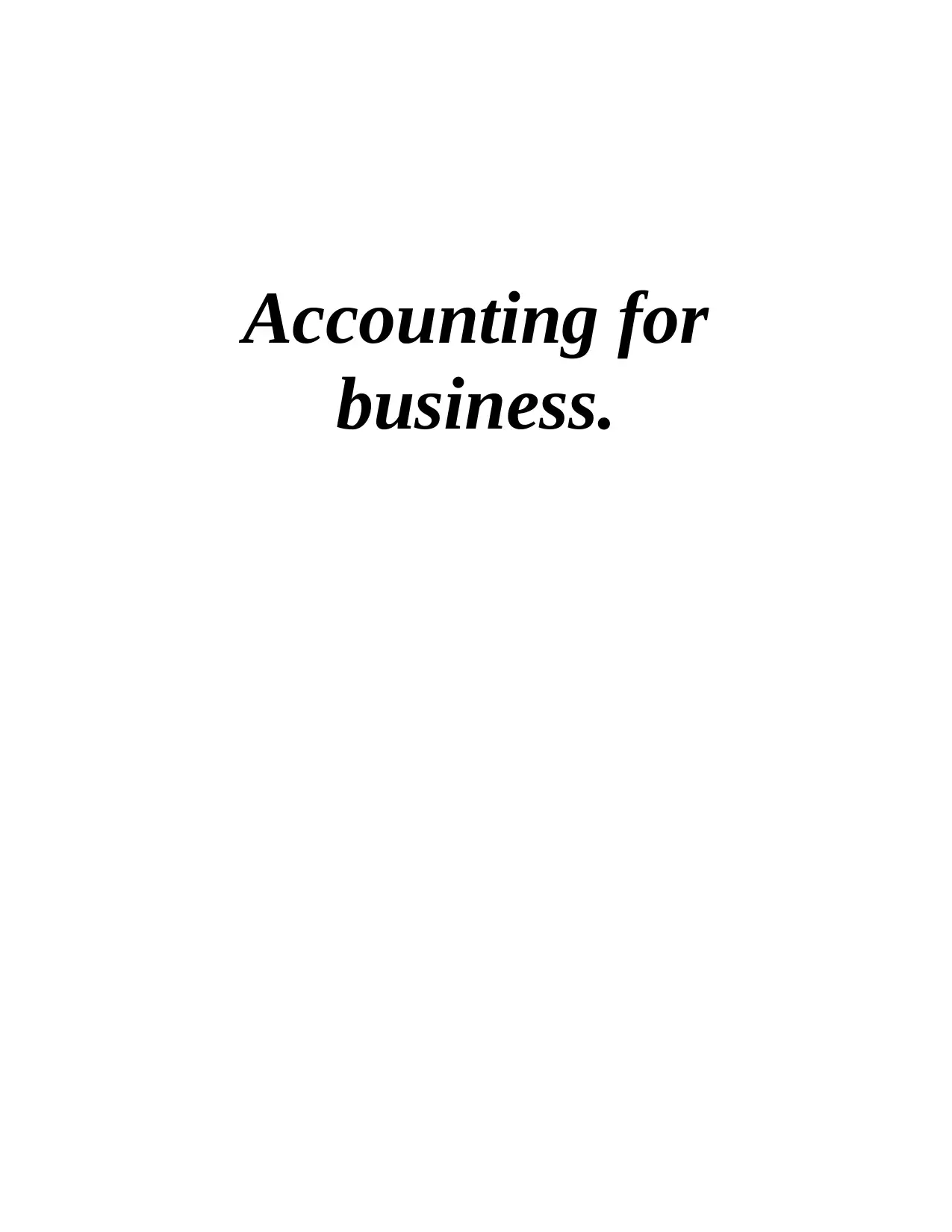
Accounting for
business.
business.
Paraphrase This Document
Need a fresh take? Get an instant paraphrase of this document with our AI Paraphraser
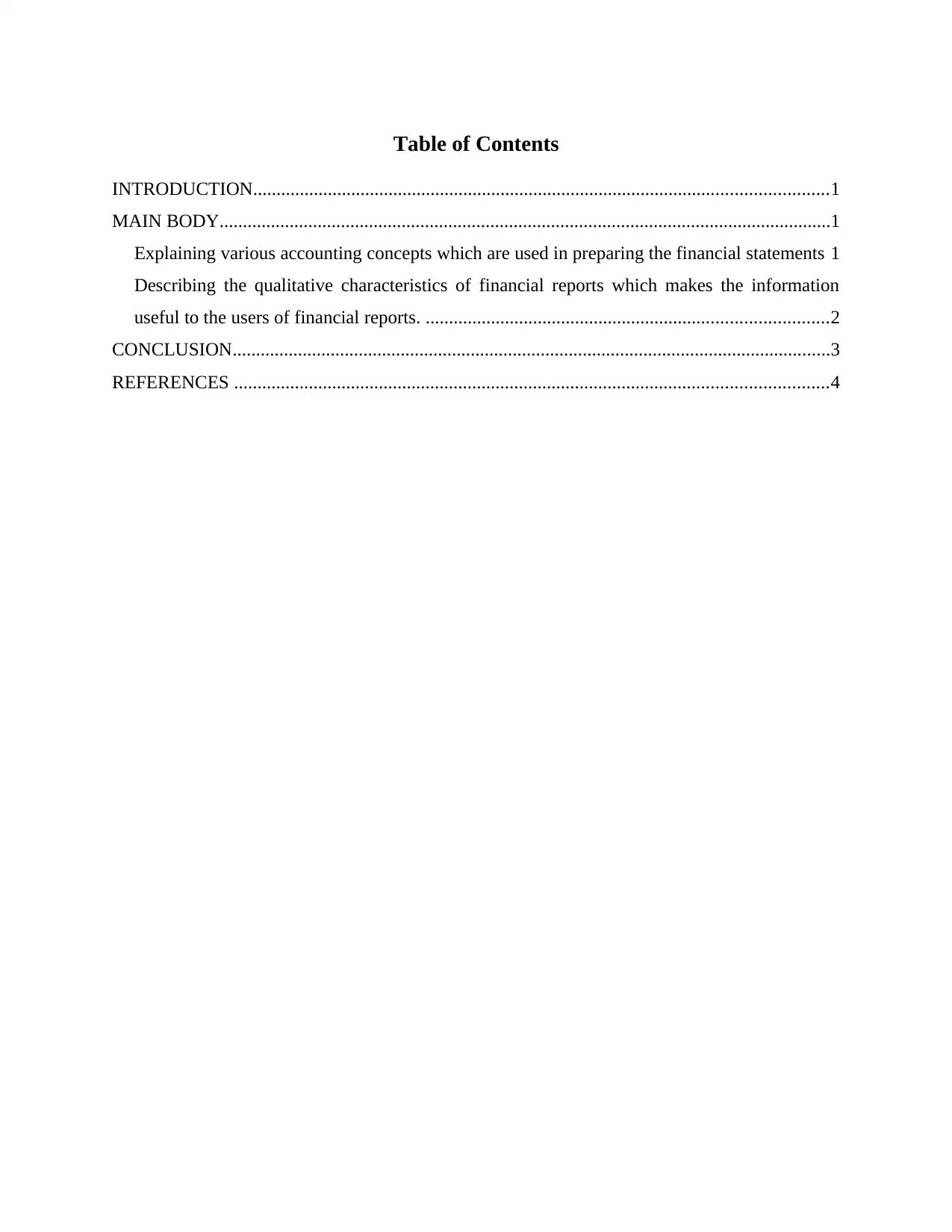
Table of Contents
INTRODUCTION...........................................................................................................................1
MAIN BODY...................................................................................................................................1
Explaining various accounting concepts which are used in preparing the financial statements 1
Describing the qualitative characteristics of financial reports which makes the information
useful to the users of financial reports. ......................................................................................2
CONCLUSION................................................................................................................................3
REFERENCES ...............................................................................................................................4
INTRODUCTION...........................................................................................................................1
MAIN BODY...................................................................................................................................1
Explaining various accounting concepts which are used in preparing the financial statements 1
Describing the qualitative characteristics of financial reports which makes the information
useful to the users of financial reports. ......................................................................................2
CONCLUSION................................................................................................................................3
REFERENCES ...............................................................................................................................4
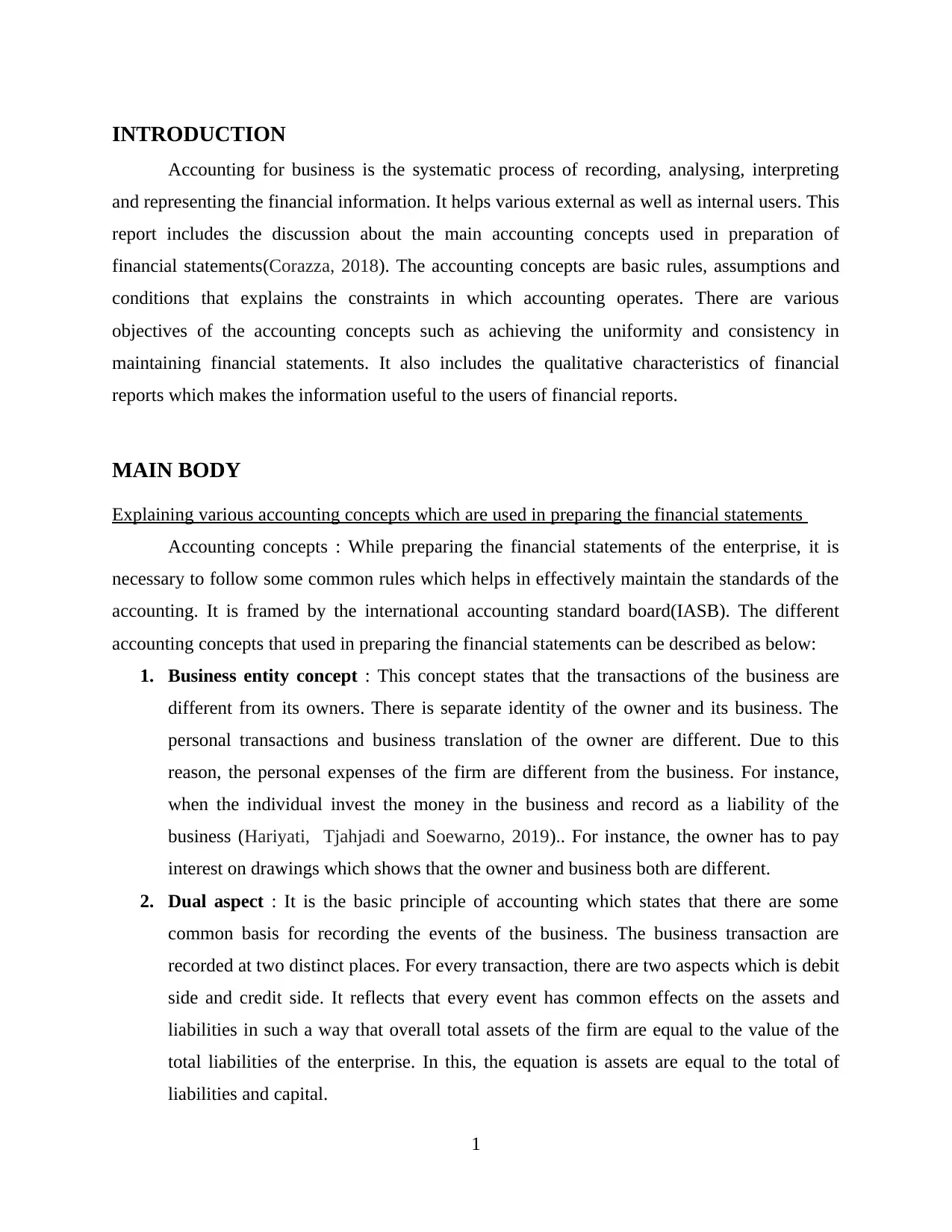
INTRODUCTION
Accounting for business is the systematic process of recording, analysing, interpreting
and representing the financial information. It helps various external as well as internal users. This
report includes the discussion about the main accounting concepts used in preparation of
financial statements(Corazza, 2018). The accounting concepts are basic rules, assumptions and
conditions that explains the constraints in which accounting operates. There are various
objectives of the accounting concepts such as achieving the uniformity and consistency in
maintaining financial statements. It also includes the qualitative characteristics of financial
reports which makes the information useful to the users of financial reports.
MAIN BODY
Explaining various accounting concepts which are used in preparing the financial statements
Accounting concepts : While preparing the financial statements of the enterprise, it is
necessary to follow some common rules which helps in effectively maintain the standards of the
accounting. It is framed by the international accounting standard board(IASB). The different
accounting concepts that used in preparing the financial statements can be described as below:
1. Business entity concept : This concept states that the transactions of the business are
different from its owners. There is separate identity of the owner and its business. The
personal transactions and business translation of the owner are different. Due to this
reason, the personal expenses of the firm are different from the business. For instance,
when the individual invest the money in the business and record as a liability of the
business (Hariyati, Tjahjadi and Soewarno, 2019).. For instance, the owner has to pay
interest on drawings which shows that the owner and business both are different.
2. Dual aspect : It is the basic principle of accounting which states that there are some
common basis for recording the events of the business. The business transaction are
recorded at two distinct places. For every transaction, there are two aspects which is debit
side and credit side. It reflects that every event has common effects on the assets and
liabilities in such a way that overall total assets of the firm are equal to the value of the
total liabilities of the enterprise. In this, the equation is assets are equal to the total of
liabilities and capital.
1
Accounting for business is the systematic process of recording, analysing, interpreting
and representing the financial information. It helps various external as well as internal users. This
report includes the discussion about the main accounting concepts used in preparation of
financial statements(Corazza, 2018). The accounting concepts are basic rules, assumptions and
conditions that explains the constraints in which accounting operates. There are various
objectives of the accounting concepts such as achieving the uniformity and consistency in
maintaining financial statements. It also includes the qualitative characteristics of financial
reports which makes the information useful to the users of financial reports.
MAIN BODY
Explaining various accounting concepts which are used in preparing the financial statements
Accounting concepts : While preparing the financial statements of the enterprise, it is
necessary to follow some common rules which helps in effectively maintain the standards of the
accounting. It is framed by the international accounting standard board(IASB). The different
accounting concepts that used in preparing the financial statements can be described as below:
1. Business entity concept : This concept states that the transactions of the business are
different from its owners. There is separate identity of the owner and its business. The
personal transactions and business translation of the owner are different. Due to this
reason, the personal expenses of the firm are different from the business. For instance,
when the individual invest the money in the business and record as a liability of the
business (Hariyati, Tjahjadi and Soewarno, 2019).. For instance, the owner has to pay
interest on drawings which shows that the owner and business both are different.
2. Dual aspect : It is the basic principle of accounting which states that there are some
common basis for recording the events of the business. The business transaction are
recorded at two distinct places. For every transaction, there are two aspects which is debit
side and credit side. It reflects that every event has common effects on the assets and
liabilities in such a way that overall total assets of the firm are equal to the value of the
total liabilities of the enterprise. In this, the equation is assets are equal to the total of
liabilities and capital.
1
⊘ This is a preview!⊘
Do you want full access?
Subscribe today to unlock all pages.

Trusted by 1+ million students worldwide
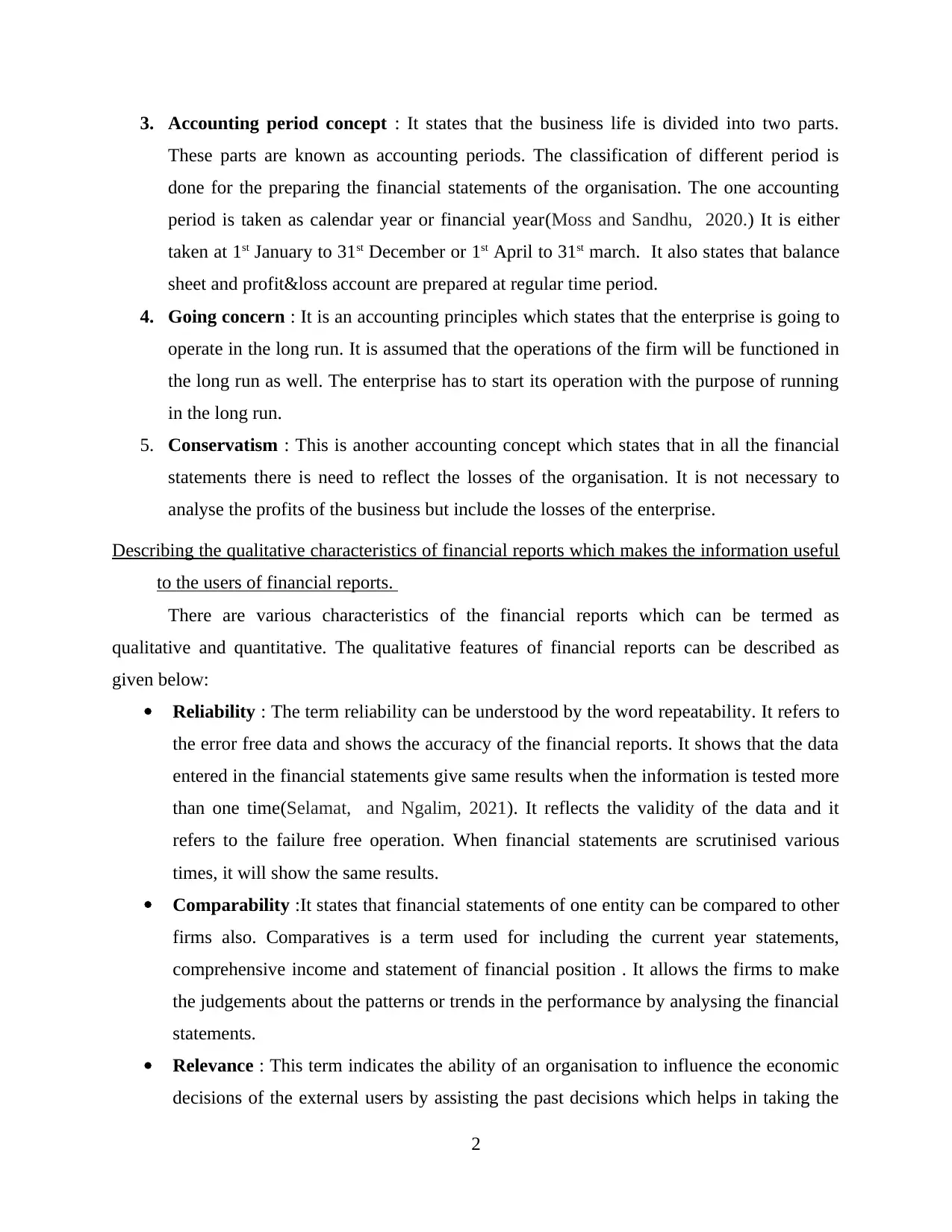
3. Accounting period concept : It states that the business life is divided into two parts.
These parts are known as accounting periods. The classification of different period is
done for the preparing the financial statements of the organisation. The one accounting
period is taken as calendar year or financial year(Moss and Sandhu, 2020.) It is either
taken at 1st January to 31st December or 1st April to 31st march. It also states that balance
sheet and profit&loss account are prepared at regular time period.
4. Going concern : It is an accounting principles which states that the enterprise is going to
operate in the long run. It is assumed that the operations of the firm will be functioned in
the long run as well. The enterprise has to start its operation with the purpose of running
in the long run.
5. Conservatism : This is another accounting concept which states that in all the financial
statements there is need to reflect the losses of the organisation. It is not necessary to
analyse the profits of the business but include the losses of the enterprise.
Describing the qualitative characteristics of financial reports which makes the information useful
to the users of financial reports.
There are various characteristics of the financial reports which can be termed as
qualitative and quantitative. The qualitative features of financial reports can be described as
given below:
Reliability : The term reliability can be understood by the word repeatability. It refers to
the error free data and shows the accuracy of the financial reports. It shows that the data
entered in the financial statements give same results when the information is tested more
than one time(Selamat, and Ngalim, 2021). It reflects the validity of the data and it
refers to the failure free operation. When financial statements are scrutinised various
times, it will show the same results.
Comparability :It states that financial statements of one entity can be compared to other
firms also. Comparatives is a term used for including the current year statements,
comprehensive income and statement of financial position . It allows the firms to make
the judgements about the patterns or trends in the performance by analysing the financial
statements.
Relevance : This term indicates the ability of an organisation to influence the economic
decisions of the external users by assisting the past decisions which helps in taking the
2
These parts are known as accounting periods. The classification of different period is
done for the preparing the financial statements of the organisation. The one accounting
period is taken as calendar year or financial year(Moss and Sandhu, 2020.) It is either
taken at 1st January to 31st December or 1st April to 31st march. It also states that balance
sheet and profit&loss account are prepared at regular time period.
4. Going concern : It is an accounting principles which states that the enterprise is going to
operate in the long run. It is assumed that the operations of the firm will be functioned in
the long run as well. The enterprise has to start its operation with the purpose of running
in the long run.
5. Conservatism : This is another accounting concept which states that in all the financial
statements there is need to reflect the losses of the organisation. It is not necessary to
analyse the profits of the business but include the losses of the enterprise.
Describing the qualitative characteristics of financial reports which makes the information useful
to the users of financial reports.
There are various characteristics of the financial reports which can be termed as
qualitative and quantitative. The qualitative features of financial reports can be described as
given below:
Reliability : The term reliability can be understood by the word repeatability. It refers to
the error free data and shows the accuracy of the financial reports. It shows that the data
entered in the financial statements give same results when the information is tested more
than one time(Selamat, and Ngalim, 2021). It reflects the validity of the data and it
refers to the failure free operation. When financial statements are scrutinised various
times, it will show the same results.
Comparability :It states that financial statements of one entity can be compared to other
firms also. Comparatives is a term used for including the current year statements,
comprehensive income and statement of financial position . It allows the firms to make
the judgements about the patterns or trends in the performance by analysing the financial
statements.
Relevance : This term indicates the ability of an organisation to influence the economic
decisions of the external users by assisting the past decisions which helps in taking the
2
Paraphrase This Document
Need a fresh take? Get an instant paraphrase of this document with our AI Paraphraser
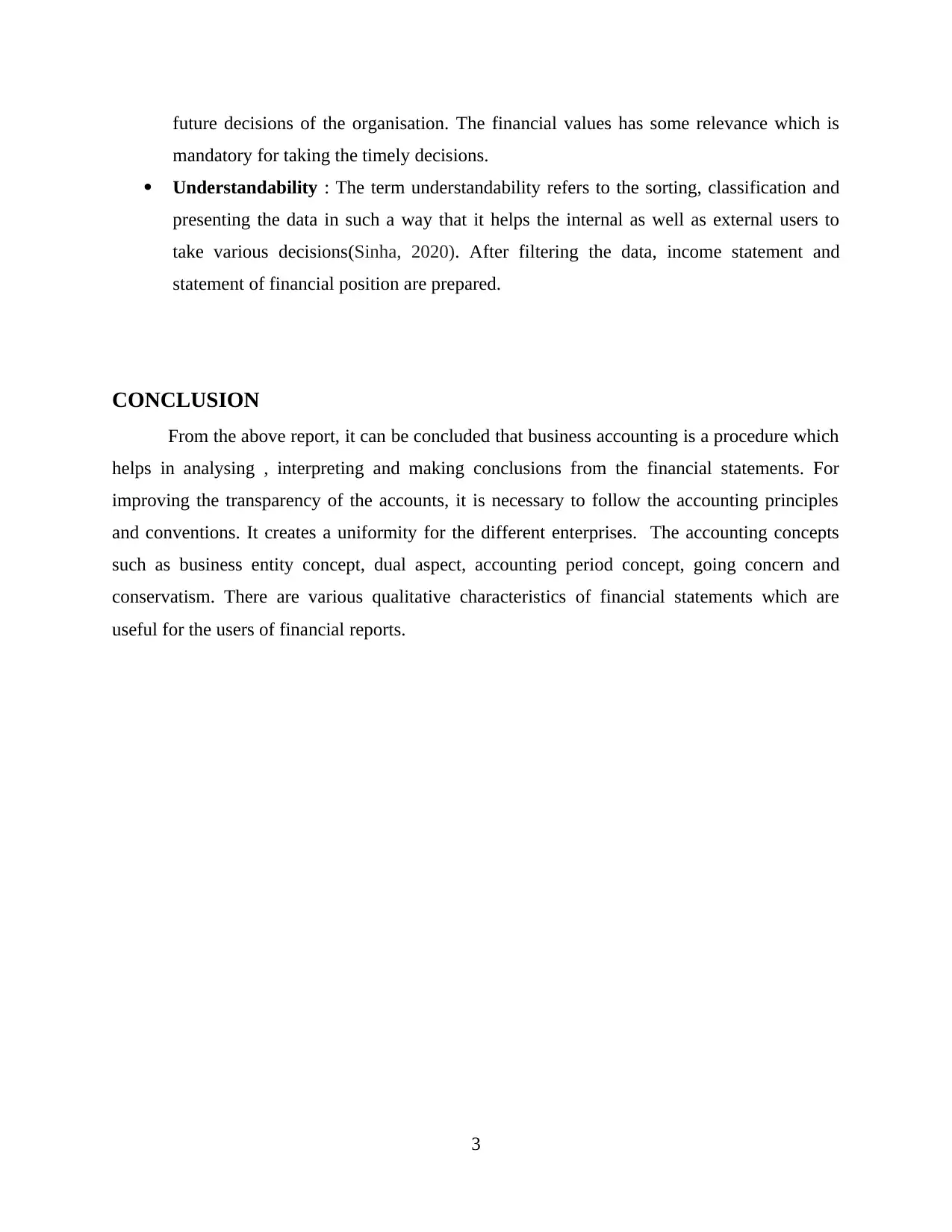
future decisions of the organisation. The financial values has some relevance which is
mandatory for taking the timely decisions.
Understandability : The term understandability refers to the sorting, classification and
presenting the data in such a way that it helps the internal as well as external users to
take various decisions(Sinha, 2020). After filtering the data, income statement and
statement of financial position are prepared.
CONCLUSION
From the above report, it can be concluded that business accounting is a procedure which
helps in analysing , interpreting and making conclusions from the financial statements. For
improving the transparency of the accounts, it is necessary to follow the accounting principles
and conventions. It creates a uniformity for the different enterprises. The accounting concepts
such as business entity concept, dual aspect, accounting period concept, going concern and
conservatism. There are various qualitative characteristics of financial statements which are
useful for the users of financial reports.
3
mandatory for taking the timely decisions.
Understandability : The term understandability refers to the sorting, classification and
presenting the data in such a way that it helps the internal as well as external users to
take various decisions(Sinha, 2020). After filtering the data, income statement and
statement of financial position are prepared.
CONCLUSION
From the above report, it can be concluded that business accounting is a procedure which
helps in analysing , interpreting and making conclusions from the financial statements. For
improving the transparency of the accounts, it is necessary to follow the accounting principles
and conventions. It creates a uniformity for the different enterprises. The accounting concepts
such as business entity concept, dual aspect, accounting period concept, going concern and
conservatism. There are various qualitative characteristics of financial statements which are
useful for the users of financial reports.
3
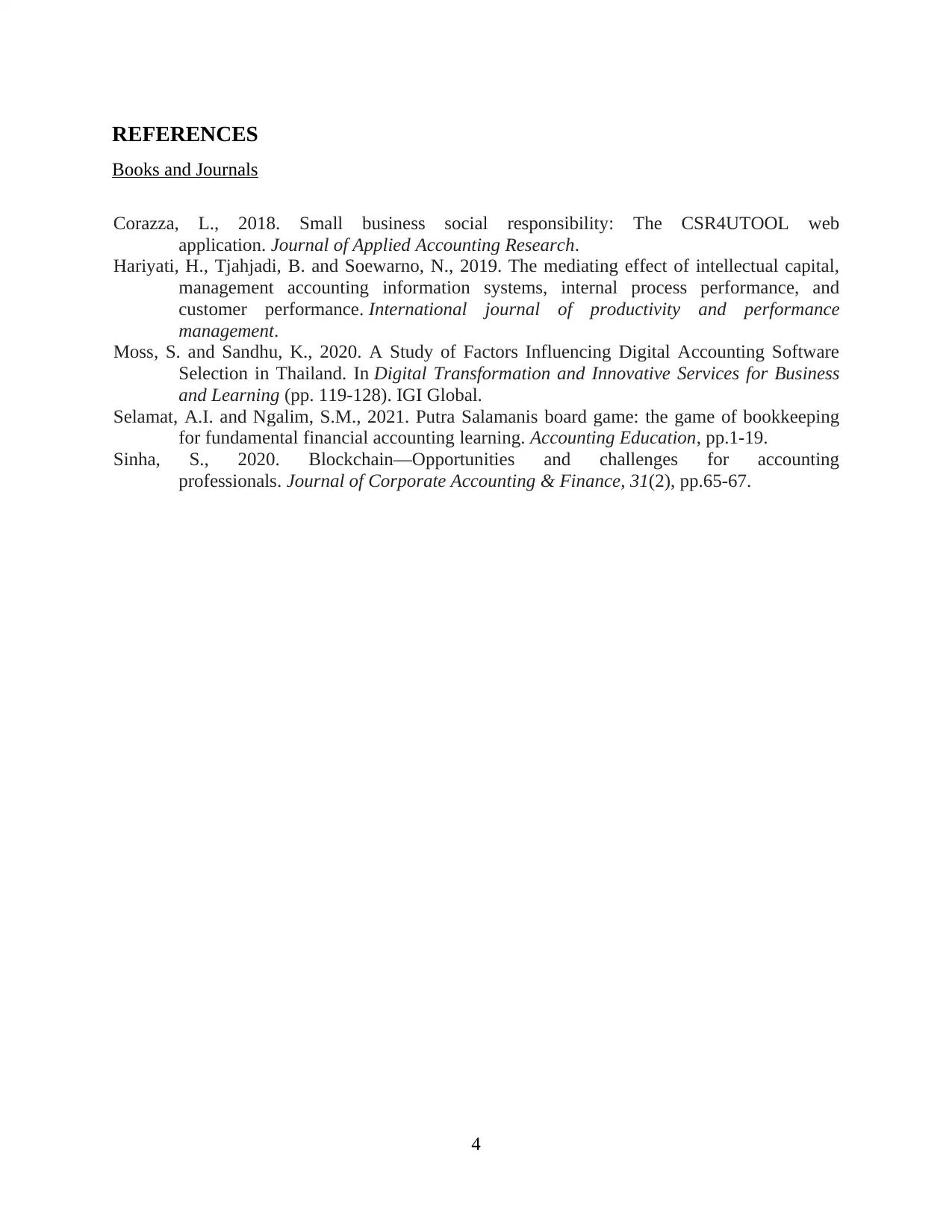
REFERENCES
Books and Journals
Corazza, L., 2018. Small business social responsibility: The CSR4UTOOL web
application. Journal of Applied Accounting Research.
Hariyati, H., Tjahjadi, B. and Soewarno, N., 2019. The mediating effect of intellectual capital,
management accounting information systems, internal process performance, and
customer performance. International journal of productivity and performance
management.
Moss, S. and Sandhu, K., 2020. A Study of Factors Influencing Digital Accounting Software
Selection in Thailand. In Digital Transformation and Innovative Services for Business
and Learning (pp. 119-128). IGI Global.
Selamat, A.I. and Ngalim, S.M., 2021. Putra Salamanis board game: the game of bookkeeping
for fundamental financial accounting learning. Accounting Education, pp.1-19.
Sinha, S., 2020. Blockchain—Opportunities and challenges for accounting
professionals. Journal of Corporate Accounting & Finance, 31(2), pp.65-67.
4
Books and Journals
Corazza, L., 2018. Small business social responsibility: The CSR4UTOOL web
application. Journal of Applied Accounting Research.
Hariyati, H., Tjahjadi, B. and Soewarno, N., 2019. The mediating effect of intellectual capital,
management accounting information systems, internal process performance, and
customer performance. International journal of productivity and performance
management.
Moss, S. and Sandhu, K., 2020. A Study of Factors Influencing Digital Accounting Software
Selection in Thailand. In Digital Transformation and Innovative Services for Business
and Learning (pp. 119-128). IGI Global.
Selamat, A.I. and Ngalim, S.M., 2021. Putra Salamanis board game: the game of bookkeeping
for fundamental financial accounting learning. Accounting Education, pp.1-19.
Sinha, S., 2020. Blockchain—Opportunities and challenges for accounting
professionals. Journal of Corporate Accounting & Finance, 31(2), pp.65-67.
4
⊘ This is a preview!⊘
Do you want full access?
Subscribe today to unlock all pages.

Trusted by 1+ million students worldwide
1 out of 6
Related Documents
Your All-in-One AI-Powered Toolkit for Academic Success.
+13062052269
info@desklib.com
Available 24*7 on WhatsApp / Email
![[object Object]](/_next/static/media/star-bottom.7253800d.svg)
Unlock your academic potential
Copyright © 2020–2025 A2Z Services. All Rights Reserved. Developed and managed by ZUCOL.




